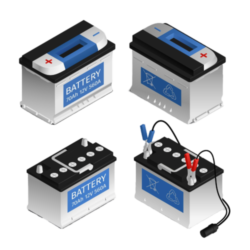Types and kinds of batteries for best results in a Solar Panel System.
Trust the best! Explore top-rated Batteries recommended by experts.
The staying power or longevity is measured by what’s called Amp Hours. On the battery, it is labeled Ah. Lithium-ion phosphate IS the battery of choice although they are more expensive. AGM Batteries are most commonly used for their cheaper price. These are what’s called deep cycle batteries. These are well-suited for long-term solar energy storage. There are also Lead-acid batteries and Golf cart batteries or marine batteries.

Car batteries are the worst to use. The reason is they use a massive amount of energy in a short amount of time and Recharge very slowly. They are poor at producing low currents for longer periods of time. Golf cart or any Deep Cycle Batteries are made to deliver a lower amount of power over a longer period of time. They recharge very quickly. They also last longer than car batteries.
However, Lithium-Ion Phosphate Batteries preferably Battle Born Brand Perform the ultimate best. They last 4 times longer up to 10 years and more if taken care of. AGM lead-acid batteries last only 2 Years. Lithium has a much better discharge at a whopping 80% or 5,000 cycles. Compare this to AGM lead acid at only 50% discharge rate.
In this video 2 tips I ‘got’ were this: If you over-supply yourself with too much storage (too many batteries); then the Solar Panels will have a hard time fully charging the batteries with each sunny cycle. Size how many batteries to about 5 times what you use each day. Also, a good strong panel will generate ‘some’ energy even on Cloudy days.
What’s inside a Tesla Battery ?
Nickel Cadmium Batteries used in Nasa’s Space Explorations
Lithium Ion Phosphate Batteries
Let’s guide you through the landscape of home solar and wind batteries. Solar batteries for your home aren’t one-size-fits-all. Each type, from lead-acid to lithium-ion, caters to varied needs and has its own set of advantages. There are many assortment of batteries, highlighting how your choice will have a sizeable impact. This affects both the efficiency and performance of your renewable energy system.
Long-lasting is key when it comes to investing in batteries. Imagine having confidence in a power source that lasts for many years. It’s essential to select a balance between the number of panels and the number of batteries you choose. This isn’t just a power factor; it’s an investment in seamless energy availability for your home.
Here are the pros and cons of the two most important types of batteries used in home energy systems: lead-acid and lithium-ion. The type of battery you choose can often decide your solar system’s long-term success and your journey toward energy independence.
Choosing the Right Type of Battery for Your Solar System
Let’s find out about the key factors that occur when selecting a battery for your home solar system. The two major types you’ll often encounter are lead-acid and lithium-ion batteries.
Lead-acid batteries are the old-school choice that has been around for decades. They’re typically more affordable upfront, but they require regular maintenance and have a shorter lifespan. Compare this to their more modern counterparts. If you’re on a tight budget and are okay with the extra upkeep, lead-acid could work for you.
Lithium-ion batteries are the newer technology on the block. They’re known for their long life, efficiency, and low maintenance. While the initial investment is higher, the lower long-term costs and stability make them an increasingly popular choice. They’re particularly effective for areas with frequent power outages or where good energy storage is critical.
It’s not just about the type of battery; it’s about how many batteries you get and how well they match the number of panels you have. A bigger investment in a high-capacity battery could mean more reliable power and less frequent discharging. This can extend the life of the battery. Discharging is the battery using up its energy. However, don’t worry too much about going all out; choose something that goes with your current and projected energy needs.
There are particular Solar Batteries for Sale that are well suited for solar and wind set-ups. The efficiency of these batteries is another crucial point. Lithium-ion batteries typically offer the better depth of discharge and round-trip efficiency, which means more of your solar power gets converted to usable electricity. It’s important to consider efficiency. It directly affects how effectively you can use the stored energy from your solar panels and wind turbines.
Factors to Consider When Selecting Solar and Wind Batteries
Choosing the best batteries for your solar or wind power system isn’t just about the type of battery. It’s a numbers game when it comes to matching the number of batteries to your solar panel array. Too few batteries and you won’t be able to store all the energy your panels are capable of producing. Too many, and you might not use all the stored energy before it naturally dissipates. Choose something that fits you and your electricity usage patterns.
Some battery types may require more maintenance than others. If you want to minimize upkeep, look at options like lithium-ion batteries. These typically need less maintenance compared to lead-acid batteries.
I really hope that you have a better grasp of the details of choosing the right batteries for your solar or wind power system. There’s a lot of opportunity to harness energy from the sun and wind. With the right setup, you’re setting yourself up for effective, sustainable energy use for many years to come.
Trust the best! Explore top-rated Solar Batteries recommended by experts.

